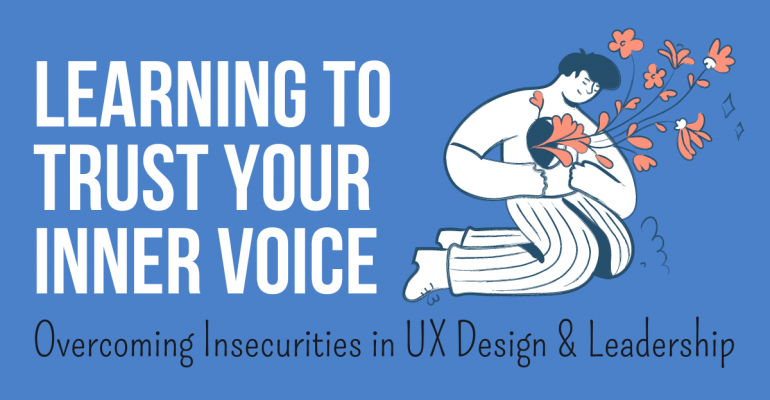Learning to Trust Your Inner Voice: Overcoming Insecurities in UX Design and Leadership
18. April 2023 2023-04-18 14:51Learning to Trust Your Inner Voice: Overcoming Insecurities in UX Design and Leadership

Learning to Trust Your Inner Voice: Overcoming Insecurities in UX Design and Leadership
We all have moments of insecurity and doubt in our lives, but for UX designers and team leads, these moments can be particularly challenging. When the stakes are high and the pressure is on, making the right decisions can feel overwhelming. Whether it’s choosing between different research methods or selecting the best team members for a project, the weight of these decisions can lead to feelings of self-doubt and uncertainty.
As a UX and leadership coach, I’ve seen these insecurities firsthand in my clients and experienced them in my own UX career. But I’m here to tell you there is a way to overcome them: by learning to trust your inner voice. By cultivating your intuition and paying attention to your gut feelings, you can become a more confident and influential leader, capable of making sound decisions with clarity and conviction.
This article will explore the challenges of UX design and leadership decision-making, the benefits of trusting your inner voice, and practical tips for developing your intuition. So if you’re ready to conquer your insecurities and lead confidently, read on!
The Challenges of Decision-Making in UX Design and Leadership
Making decisions is never easy, but UX design and leadership stakes can be exceptionally high. From choosing between different research activities, creative methods, or design solutions to selecting team members for a project or deciding on a long-term strategy, every decision has the potential to impact the success of a product, team or organisation. This pressure can lead to feelings of insecurity and doubt, making it challenging to make sound decisions.
One of the biggest challenges of decision-making is uncertainty. There are often no clear-cut answers or right or wrong decisions in UX design. Instead, there are trade-offs and competing priorities that must be balanced. This can lead to analysis paralysis, where designers and team leads get stuck in a cycle of overthinking and indecision.
Another challenge is the pressure to achieve consensus. Many design projects have multiple stakeholders with different opinions and priorities. Reaching an agreement can be time-consuming and challenging, and it can be easy to second-guess oneself when faced with conflicting feedback.
Finally, there is the challenge of making decisions under time pressure. In fast-paced industries like UX design, decisions often must be made quickly, leaving little time for reflection or analysis. This can lead to hasty decisions that are not well thought out, further fueling feelings of insecurity.
All of these challenges can lead to feelings of self-doubt and insecurity, making it difficult to make sound decisions. But there is a way to overcome these challenges and develop confidence in decision-making: by trusting your inner voice.
The Benefits of Trusting Your Inner Voice
Trusting your inner voice means relying on your intuition and gut feelings to guide your decisions. This may seem like a risky approach, but in reality, there are many benefits to listening to your inner voice.
First and foremost, trusting your intuition can increase your confidence. When you listen to your inner voice, you tap into a deep well of wisdom from your past experiences and knowledge. This can give you the courage to make decisions with conviction, even in the face of uncertainty.
Trusting your intuition can also lead to more explicit decision-making. When you’re not second-guessing yourself or worrying about what others might think, you can make decisions more quickly and with greater clarity. This can be especially valuable in fast-paced industries like UX design, where decisions often must be made quickly.
Another benefit of trusting your inner voice is that it allows you to stay true to your values. When making decisions based on intuition, you tap into a more profound sense of purpose and meaning. This can help you make decisions aligned with your values rather than just going along with what others expect of you.
Finally, trusting your intuition can be fun! When you’re in touch with your inner voice, you can tap into a sense of playfulness and creativity. This can lead to more innovative and exciting design solutions and greater enjoyment in your work.
Of course, it’s important to note that trusting your inner voice shouldn’t replace data-driven decision-making or rational thinking. Instead, it should be used in conjunction with these approaches to complement and enhance your decision-making abilities. By balancing your intuition with evidence and analysis, you can make sound informed and inspired decisions.
Practical Tips for Developing Your Intuition
Trusting your inner voice is a skill that can be developed over time. Here are some practical tips for cultivating your intuition and using it to make better decisions:
- Practice mindfulness: Mindfulness is the practice of being present in the moment and paying attention to your thoughts and feelings without judgment. By practising mindfulness regularly, you can become more in tune with your inner voice and better recognise when it’s trying to guide you.
- Reflect on past experiences: Your past experiences can provide valuable insights that can guide your decision-making in the present. Take time to reflect on past decisions you’ve made, both good and bad, and think about what you learned from them. This can help you develop a deeper understanding of your own decision-making process and hone your intuition.
- Trust your initial reactions: When faced with a decision, pay attention to your initial reactions. Your gut instincts can often provide valuable insights that you may not be able to articulate through rational thought alone. Trust these reactions, even if they go against conventional wisdom or what others may tell you.
- Take time to reflect: When making important decisions, it’s essential to consider all options. However, it’s equally important not to overthink or get stuck in analysis paralysis. Find a balance between reflection and action that works for you.
- Get feedback from others: While trusting your inner voice is meaningful, getting input from others is also valuable. Seek out the opinions of trusted colleagues or mentors, and be open to constructive feedback that can help you refine your decisions.
By incorporating these tips into your decision-making process, you can become more confident in trusting your intuition and using it to guide your decisions. Remember, trusting your inner voice is a skill that takes practice, so be patient with yourself and keep practising!
Conclusion
Trusting your inner voice is a vital skill for anyone. Still, it’s particularly critical for UX designers and team leads who often face complex decisions that can significantly impact their work. By listening to your intuition and trusting it to guide your choices, you can increase your confidence, make more straightforward decisions, stay true to your values, and enjoy your work more.
Remember, trusting your intuition doesn’t mean ignoring data or rational thought. Instead, it’s about balancing your intuition and other decision-making approaches to make the best choices possible.
If you need help in trusting your inner voice or want to develop your intuition further, consider working with a UX and leadership coach. As a coach, I can help you develop practical skills for listening to your intuition, navigating difficult decisions, and finding balance in your work and life. Feel free to contact me if you’re interested in working together.
In conclusion, don’t be afraid to trust your intuition and listen to your inner voice. With practice and patience, you can develop this valuable skill and use it to make better decisions and enjoy your work more.
Further Reading
Carson, L. (2017). The importance of intuition in the design process. LinkedIn Pulse. https://www.linkedin.com/pulse/importance-intuition-design-process-luke-carson/
Ferrer, J. (2022). The power of intuition — Designing beyond usability. Medium. https://uxdesign.cc/the-power-of-intuition-designing-beyond-usability-2899cb37f98a
Stupple, L. (2022). 4 Reasons Intuition Is an Essential Leadership Skill. Entrepreneur. https://www.entrepreneur.com/leadership/4-reasons-intuition-is-an-essential-leadership-skill/426726







